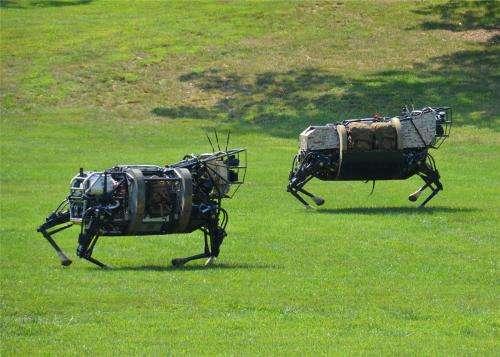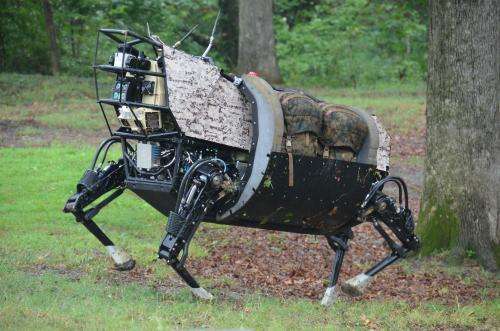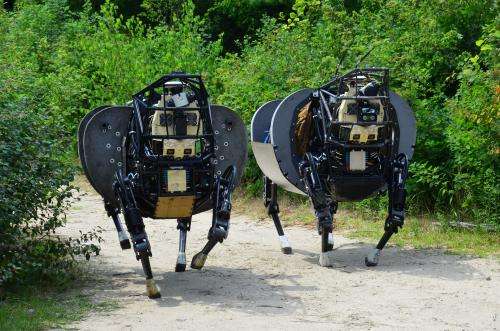Credit: DARPA
(Phys.org)—Today's dismounted warfighter can be saddled with more than 100 pounds of gear, resulting in physical strain, fatigue and degraded performance. Reducing the load on dismounted warfighters has become a major point of emphasis for defense research and development, because the increasing weight of individual equipment has a negative impact on warfighter readiness. The Army has identified physical overburden as one of its top five science and technology challenges. To help alleviate physical weight on troops, DARPA is developing a four-legged robot, the Legged Squad Support System (LS3), to integrate with a squad of Marines or Soldiers.
LS3 seeks to demonstrate that a highly mobile, semi-autonomous legged robot can carry 400 lbs of a squad's load, follow squad members through rugged terrain and interact with troops in a natural way, similar to a trained animal and its handler.
The LS3 program goal is to develop a robot that will go through the same terrain the squad goes through without hindering the squad's mission. The robot could also serve as a mobile auxiliary power source to the squad, so troops can recharge batteries for radios and handheld devices while on patrol.
In January 2012, the LS3 prototype completed its first outdoor assessment, demonstrating mobility by climbing and descending a hill and exercising its perception capabilities.
Credit: DARPA
A two-year, platform-refinement test cycle began in July 2012, with Marine and Army involvement, culminating in a planned capstone exercise where LS3 should embed with Marines conducting field exercises. During this period, DARPA seeks to finish the development of and refine LS3's technologies to provide a suite of autonomy settings, including leader-follower tight, leader-follower corridor and go-to-waypoint, described below:
- Leader-follower tight: LS3 attempts to follow as close as possible to the path its leader takes
- Leader-follower corridor: LS3 sticks to the leader but has freedom to make local path decisions, so the leader doesn't need to think about LS3's mobility capabilities
- Go-to-waypoint: LS3 uses its local perception to avoid obstacles on its way to a designated GPS coordinate
Credit: DARPA
LS3 represents the culmination of a decade of research in perception and autonomy with programs like DARPA's Unmanned Ground Combat Vehicle-Perception for Off-Road Robotics Integration (UPI) program, mobility work with DARPA's "Big Dog" and significant advances in natural human-robot interface such as voice recognition.
Provided by DARPA

























